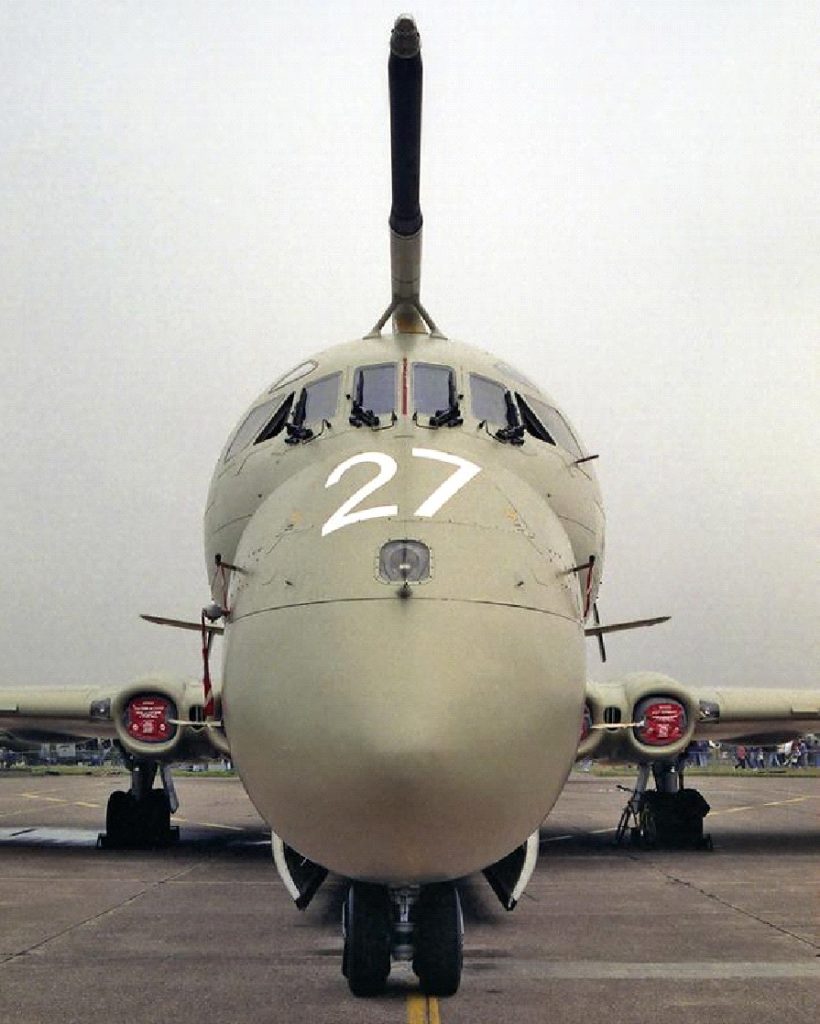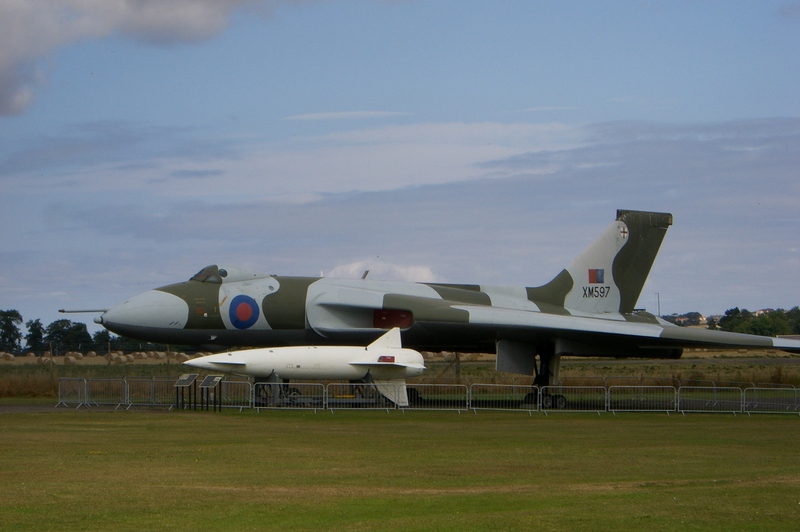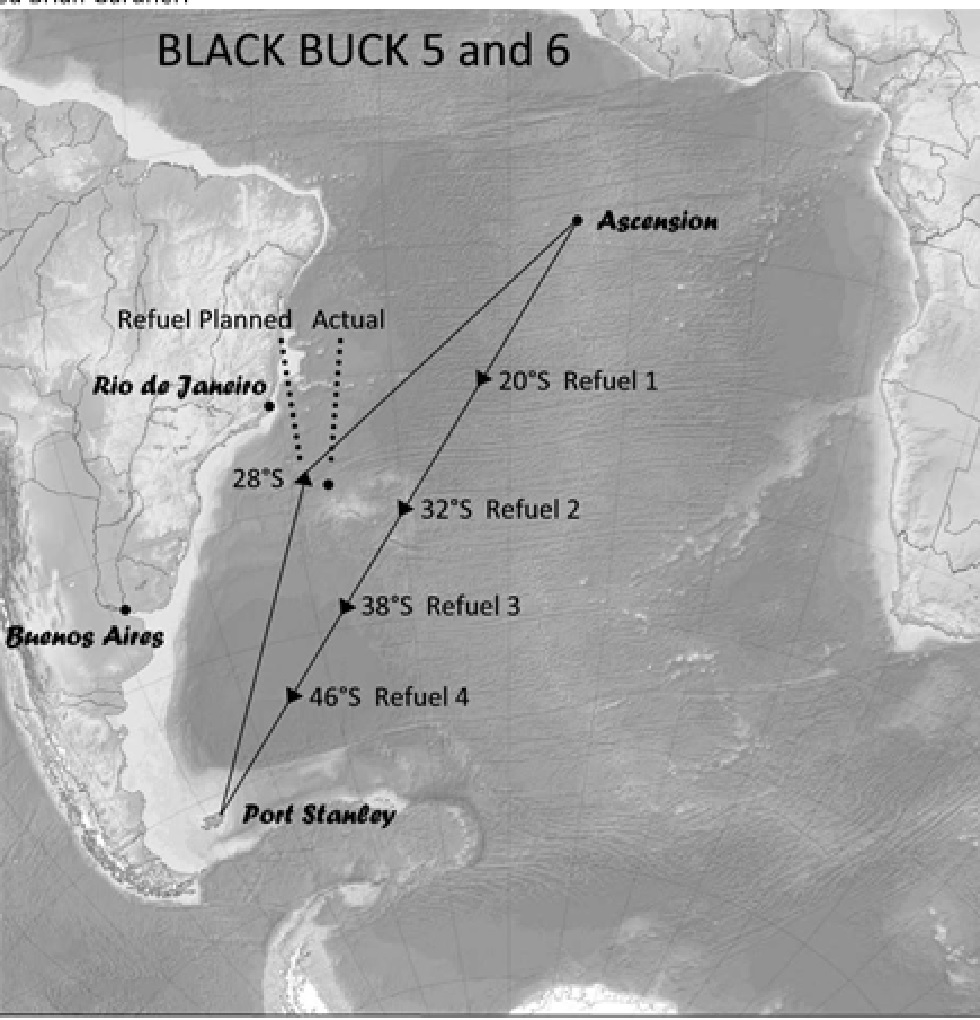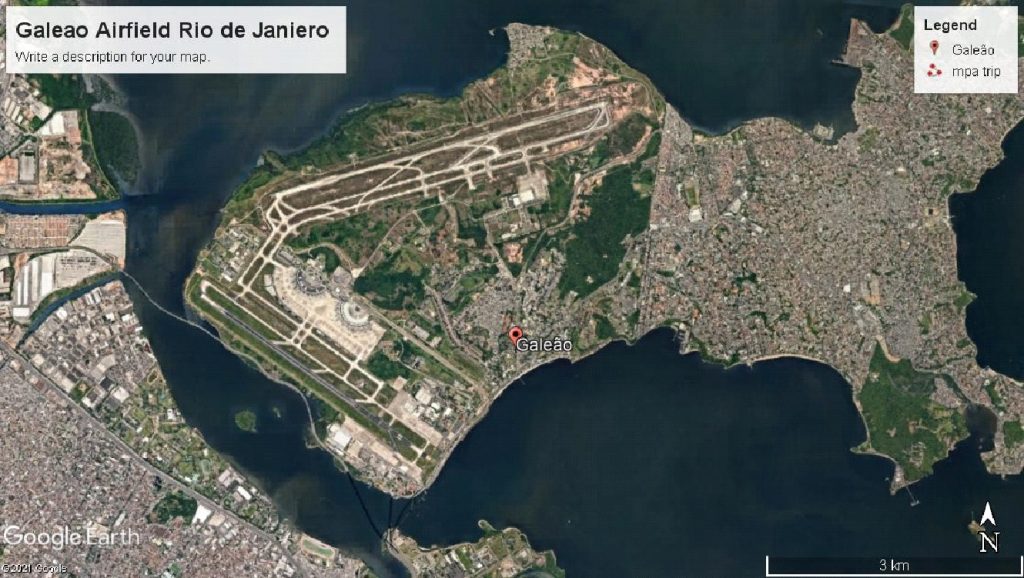
Before this article I’d like to clarify that this is a combined effort between myself and the Lead
Dry AEOp on the same crew and sortie, Jeff Spencer. We collaborated on this, the result is
below:-
On the 3rd of June 1982, XV227 got airborne from Ascension Island; this was, of course, the
Falklands War.
The purpose of this Nimrod sortie was to provide SAR top cover for the final in-flight refuelling
of Vulcan B2 XM597 at its last northbound re-fuelling en route from the Falkland Islands back to
Ascension Island. The secondary mission was to gather useful radar and EW intelligence on the
planned route. This Vulcan mission was Black Buck 6 and the plan, though we all know no plan
survives contact with the enemy, was to take out the 4 very capable Argentinian 3D search and
acquisition radars (AN/TPS 43) on the Falklands. These radars were tracking task force air
movements out to 200 miles giving vital situational awareness on the positions of the flat tops
and making life difficult for the Harrier boys. Just to add a little spice to an already complex
mission; the 4 SHRIKE anti radar missiles needed to do the job were leant to us by the USA who,
at the time of the mission, was publicly not taking sides and neatly ‘sitting on the fence’. God
bless the spams. NB. It might have helped that John Lehman, Sec Navy was ex Cambridge Uni
and Casper Weinberger was a real Anglophile. Amongst many favours were fuel supplies to
Ascension, SHRIKE (ground radar seeking missiles), Aim 9L (much improved over current RAF’s
9G) and the latest US TacSat so the SF boys could tell PJHQ what they were watching in real
time.
Plainly, it was the Vulcan guys who would face the greatest threat; particularly over the target
area and on the egress; especially if the Argentinians had any Mirages on alert from the
mainland or if the Argentinian Type 42s had ventured out to sea: It would have been a real
travesty for either of us to be taken out by an ex-UK warship fitted with a British built long range
Sea Dart missile system.
Remember: on 3 June, we knew very little about Argentinian forces. The Fuerza Aerea
Argentine, their Air Force, had 200 combat ac. Professional and well equipped Mirage III
fighters. Israeli built IAI Daggers and the US Douglas A-4 Skyhawks plus Ex British Canberra
bombers and the FMA IA-58 Pucara twin prop GA ac. The Commando de Aviación Naval (Naval
Air) operated the Super Etendard and their French sea skimming AM 39 was a potent threat.
There was also uncertainty regarding ability of SuE to operate from 25 de Mayo but this was
considered a possibility by high grade intelligence: as we now know, she stayed mostly in port;
well away from any nasty British nuclear submarines.
It was fair to say that so early in the conflict our preflight intelligence brief was somewhat
sparse.
All we could do was utilise our sensors to best effect for intelligence and self protection.
Fortunately, we were equipped with the Mk 2 Nimrod, the first of which was delivered to 206
Sqn in late 1979, with the second jet not delivered till late 1980. By 1982, I think we had about 6
Mk 2 jets. Our Searchwater radar was world leading and as well as tracking large contacts out
to 200 nm, we could also conduct very accurate identification of surface traffic out to about 150
miles of track. The radar gave the operator a profile which closely resembled the shape of the
surface traffic and made a classic triangular warship particularly obvious. The Israeli Loral, or
Yellowgate ESM system, though clearly far more sensitive than our old Arar Arax open receiver
predecessor, operated on a predetermined frequency search. I think it’s fair to say that in war,
many of us would have been more comfortable with the more open receiver of our old ESM
system: Trusting that a predetermined scan was operating while a threat radar was illuminating
us was a considerable leap of faith.
The jet had also been extensively and rapidly retrofitted with chaff and flare dispensers and the
crew had trained on multiple air to air affiliation sorties using mostly RAF F4s from Leuchers. As
I recall, with good crew cooperation we could often evade a singleton through slow speed
manoeuvrability, but a coordinated pair would take us every time. From my memory, we had
not yet been fitted with the Aim 9G Sidewinders which would have at least improved our
confidence; if not our ability to take out a Mirage in combat.

The Nimrod and the Victor Tanker got airborne more or less the same time and transited to the
final Vulcan RV point.
The area for the refuelling to take place is shown in the map below.

The Vulcan, at this time, was heading North to the same point for its desperately needed
re-fuelling en route to Ascension.
The outbound transit was unremarkable for both Nimrod and Victor, though I do recall us
carrying out some minor deviations from track to avoid potential radar and ESM surface threats
which would have required too much time to investigate and verify as safe. These were
reported post flight and indeed correlated with Task Force reinforcements tracking to the
operational area. The Nimrod was re-fuelled from the Victor tanker during the transit as we
would have been unable to provide the SAR cover and return to Ascension without this top up.
Approaching the Vulcan RV, communications between the Victor and Vulcan were correctly
sparse and both conducted a standard join which allowed the Vulcan to commence the refuel
procedure. The Nimrod was to remain to the East of the RV on radio silence unless called upon:
As it happens, the best laid plans were about to fail.
For reasons unknown to us at the time, there were 5 unsuccessful attempts to refuel and the
6th attempt resulted in the Vulcan probe literally breaking in the receiver basket. The Victor was
then of no use to anyone with the probe in the basket, so it departed to ASI. The Vulcan and
Victor had been at 33000 ft and the Nimrod was at 42000 ft.
Once it became clear we were going to escort the Vulcan to Rio, we cruise climbed to get over the top of the Brazilian coastal
radar lobes, memory is short these days but I think we got to 47000ft. The Nimrod has a graph
of Vstall in one line and Mach NE in another the Y axis being altitude, X being IAS (from
memory!) This is based on 2g, the VStall and Mne converge with increase in altitude, 42000ft
being the “service ceiling” at the A/C 2g limit. This graph was modified for this campaign and
was redrawn for 1.8 g, 1.6g, and 1.4g (I think) This meant that the lines converged at higher
altitudes, as long as G wasn’t increased, all should be fine(!!!)
Communications; both short range and long range suddenly took on a whole different urgency,
and our minimise comms went straight out of the window. Plainly, the first course of action was
a remarkably rapid Mayday declaration by the Vulcan: At that stage, they had no idea if the fuel
remaining was enough even to land at Rio.
Our first priority was to inform the UK Government via a high classification Flash message that
one of its military ac was now en-route Brazil after launching 3 missiles at Argentinian owned
radars; even worse, she was still carrying a hung United States-owned SHRIKE missile; and was
unlikely to be able to discard the weapon before landing. Politically embarrassing!
Despite the delicacy of the situation it has to be said that the interchange between the Vulcan,
declaring itself as a military 4-jet, and ATC who were desperate to know its actual type was
almost a comedy sketch; at least in the Nimrod. In short, every time ATC asked a question, the
Vulcan crew requested a height change. Quite a neat avoidance tactic.
Clearly, the Vulcan did two things: headed West and climbed to conserve fuel. However, as part
of their evolving comedy sketch, the crew realised they had to dump some serious secret
squirrel stuff in the South Atlantic. This clearly required a depressurisation but unfortunately
they also inadvertently threw out some essential en route charts, navigation details and airfield
information – oops! Fortunately, our Navs were able to assist over UHF.
The black comedy continued with the arrival of a US ATC supervisor on to the frequency: His
attempts to extract an aircraft type were as unsuccessful as his earlier Brazilian colleagues.
Internal crew suggestions on the Nimrod that the Brazilians might want to turn the ATC radar off
may have been a little inappropriate but also kept us mildly amused. I call it military humour.
The Vulcan finally called runway visual and the air traffic guy finally gave up asking for their
aircraft type: I recall his last words being “I’ll see you for myself soon”.
Obviously, the safe landing was a blessing but it had to be said that some of us quite fancied a
det in Rio.
Postscript: The Vulcan crew were well entertained by the Brazilian Air Force hosts, and the UK
Embassy staff furnished the crew with jeans, T Shirts and trainers for their stay: hardly
appropriate for RAF Officers and even worse; the Embassy billed them on their return to UK:
I’m told that no one actually paid.
We never did find out what happened to the remaining SHRIKE.
We were now able to return to ASI descending to below 42000ft for safety reasons, in event of a
depressurisation our O2 systems were only rated, with pressure breathing up to 42000. From
our ECM we knew that we had never been “seen” by any other radar, so, in reality, no-one on
the ground ever knew we had been there.
We landed safely after 11hrs 15mins, back at ASI
Yet another day in the office!!
I am able to say I’ve been near to Rio, just 8miles away, all downwards!

Ian Harvey
F/E XV227
Jeff Spencer
AEOp – Radar, Radio and ESM
Lead Dry AEOp XV227